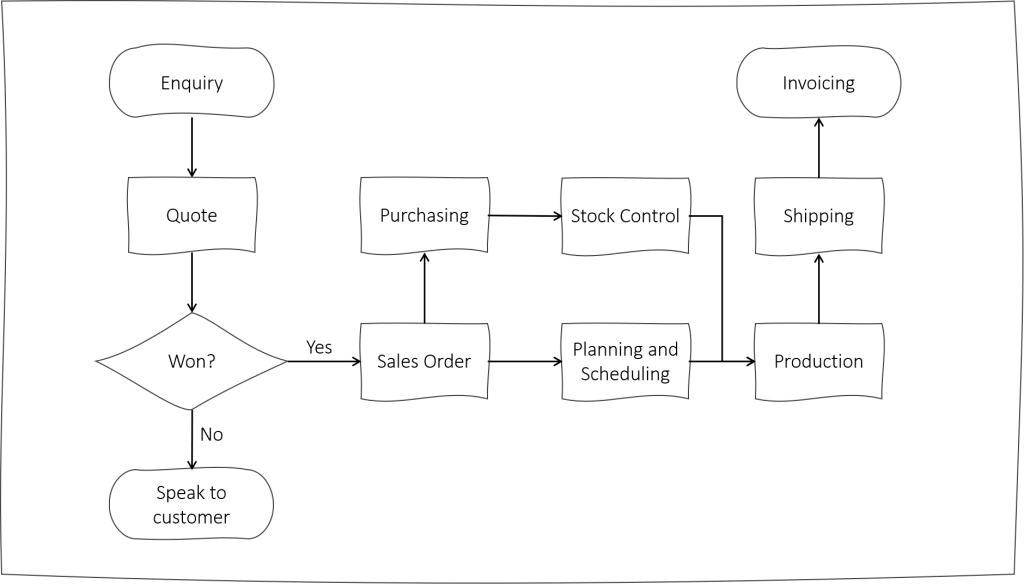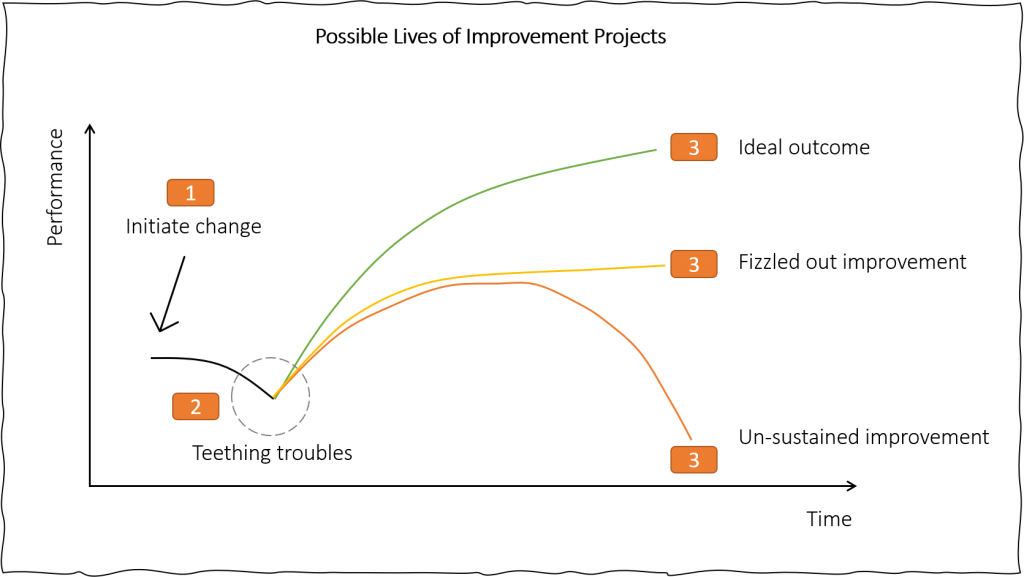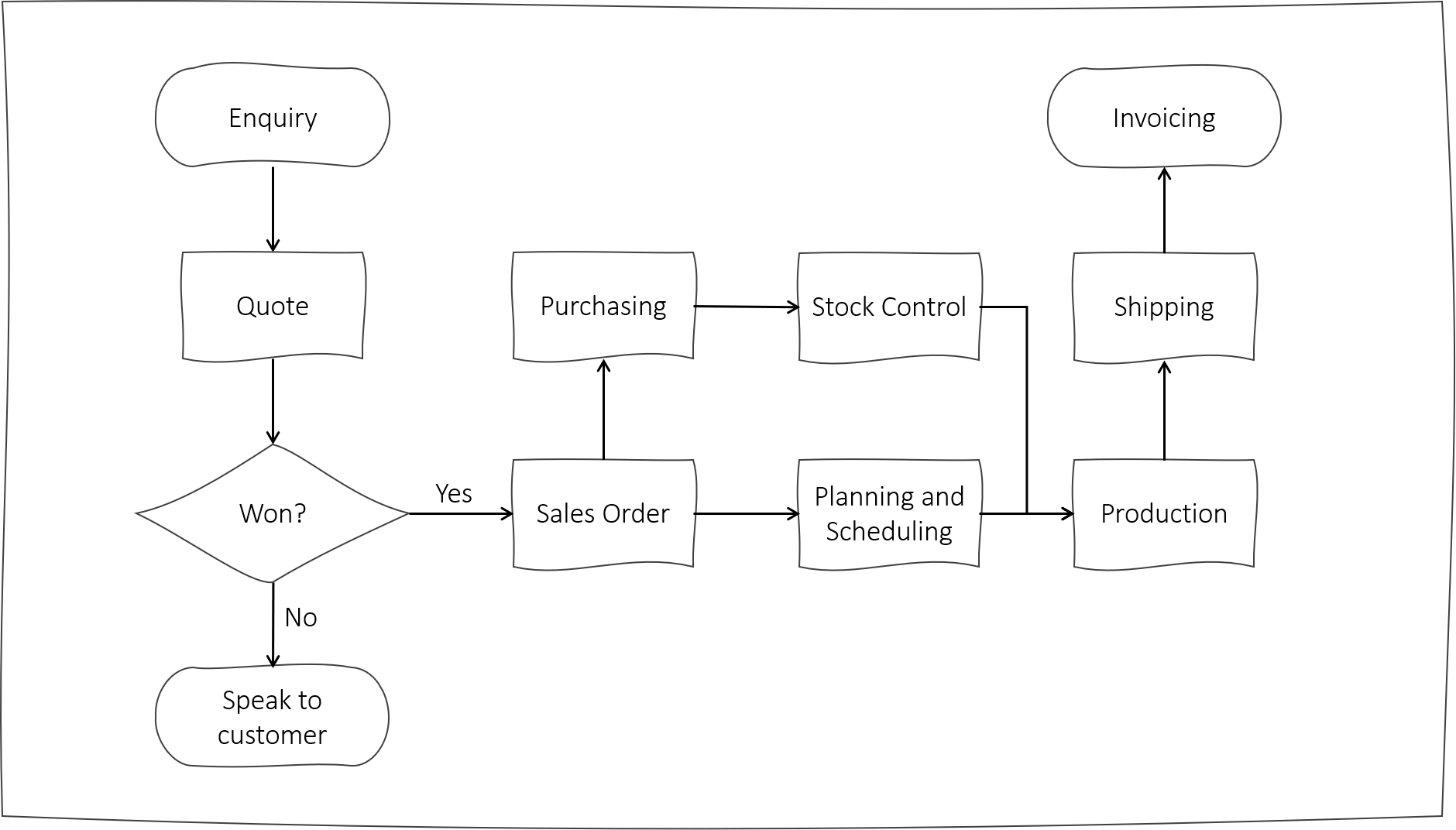Business process mapping is an exercise to help you see your business clearly. Its purpose is to facilitate improvement activity. In this case it is a means to an end to drive business performance.
Benefits
A good process mapping exercise can help your business in many ways:
- Bring your team together.
- Improve productivity and on time delivery.
- Simplify working practices.
- Raise quality levels and natural capacity.
- Improve general understanding.
Scope
Before you start your business process mapping exercise, you need to be clear on the start and the end.
- Where do you want to begin?
- What process are you trying to capture?
- What point do you define its conclusion?
The scope doesn’t have to be perfect; it has to be clear. If you don’t have a clear scope it makes it harder for the people participating. They need to know where to begin and where they need to arrive.
Involve your team
One of the big benefits of business process mapping is engaging your team. Getting a variety of viewpoints can provide a much better insight than doing this on your own.
Try to gather a team that has a big overlap of knowledge, but with specific knowledge too. Different experiences and perspectives will add depth to your mapping exercise.
Also, there may be many misunderstandings within your business currently. A mapping exercise can help to bring these issues to the surface and allows you to deal with them.
Fast capture method
This article’s title is ‘fast business process mapping’ for a reason!
There are many ways that you can undertake business process mapping. Let me share with you one of the fastest ways to get started.
With your team, arrange yourselves around a large whiteboard or roll of brown paper. With sticky notes in hand, start at your beginning and ask this question:
“what happens next?”
Write the answer down on the sticky note and place next to your start point. Keep asking the question until you reach the end of your scope.
When you have all the steps laid out, you can do the following:
- Review the steps to ensure that they make sense.
- You can work backwards, to test the logic. You can link the steps together in this fashion – Y happened because I did X… If the statement doesn’t make sense then double check what you have recorded.
- Check for decision points that you haven’t recorded. If there are any gaps in the thinking process identify them and include them.
- When you are happy, link the sticky notes together with arrows – drawn onto the brown paper / whiteboard.

Warts and all
I need to stress at this point that this exercise has to be warts and all. The point of business process mapping is to help visualise reality.
Don’t skip over parts of the process that are difficult.
Don’t jump past complicated parts of the process that are hard to explain.
Don’t merge several steps into one sticky note. It is better to have five steps that are accurate than one that doesn’t help you later on.
Be explicit about each step in your process map.
Include data
Facts and figures can help you to make sense of your process map. Don’t feel the need to go overboard with this, the point is to create a fast process map.
If there is key information that helps the team understand the situation then include it. This could include items such as quality levels, yields, lead times, delivery rates, volumes etc…
Grumble and improve
Your business process mapping can be an opportunity to grumble. Grumbling in this context is good.
Grumble about the elements that:
- Don’t work.
- Don’t make sense.
- Are too slow.
- Are too difficult.
- Could be better.
- Take too much time.
List out the improvements and keep them to one side for your improvement plan.
Figure out what good looks like
If you feel that your grumble is tinkering around the edges then you might need another approach. Asking yourself and your team the question “what does good look like?” may give you the right push.
Creating a vision for the future of your business processes doesn’t have to be difficult. This question can be enough for many situations.
Why should we do this? There is little point in small improvements when a change of direction is much better. Let me give you an example.
An organisation identified approximately 50 improvements to reduce a process’ lead time. The prediction for these improvements was a 10% reduction. Moving to a self-service system required only three changes and offered an 85% lead-time reduction.
Future state plan
Pull together your current improvements and any ‘what does good look like?’ points. Combining the two should push your business process mapping into an optimised plan. This becomes your future state plan and something concrete to work to.
Many businesses halt their business process mapping exercises with the current state. Failure to continue into the future state decimates the potential of the opportunities.
Remember the ‘Y Curve’
This point is quick reminder, once your business process mapping has concluded. When you move into improvement, don’t expect immediate results for all your changes. Some will take longer than expected. Some will take more effort than expected. Some will need a few tweaks.
The ‘Y Curve’, as shown below, gives you a few different outcomes when considering change.
The basic lesson? Stick with the change and be flexible with your application until you get the results you want.

Summary
Business process mapping can be daunting but it doesn’t need to be. Take the points in this document and quickly map your business processes. Find the obvious improvements and consider the ideal future state at the same time.
Pulling the findings from your mapping exercise together can define a powerful plan. This plan can lead you to higher profits, happier customer and a (slightly) easier life!
